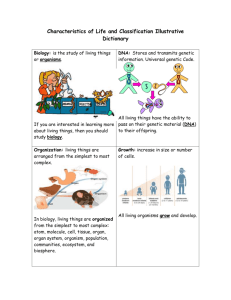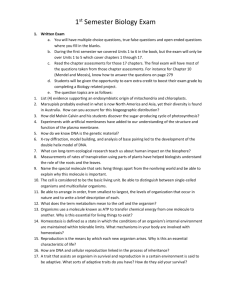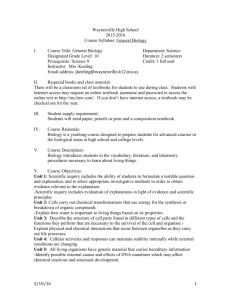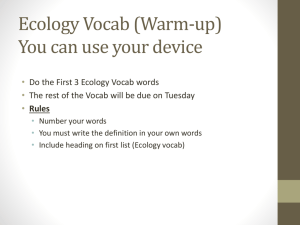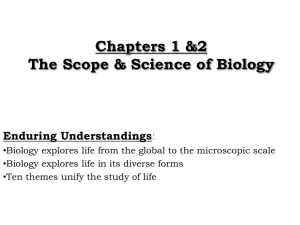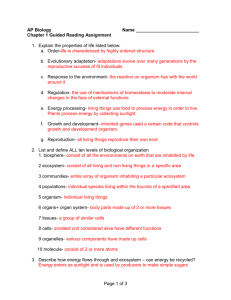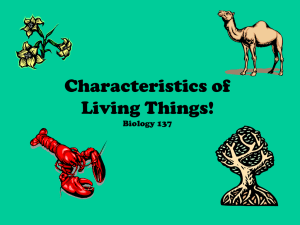Honors Biology Chapter One Power Point
advertisement
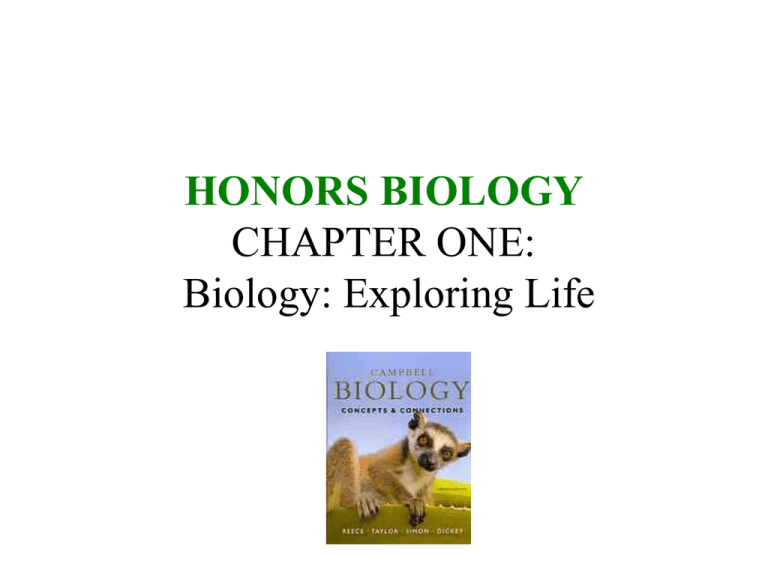
HONORS BIOLOGY CHAPTER ONE: Biology: Exploring Life Biology • The Scientific Study of Life Characteristics of Life • An organism must have all seven of these in order to be considered as living. • 1. Order Characteristics of Life youtube • 2. Reproduction 5:24 • 3. Growth and development • 4. Energy Processing • 5. Respond to the Environment • 6. Regulation • 7. Evolutionary adaptation 1. ORDER Living things are made of cells • These units help to organize their materials. Nerve cell Examples of Cells Egg and sperm Red blood cell Fat cell Cheek cell 2. REPRODUCTION • Why is this so important? • How do plants reproduce? • How do animals reproduce? Egg and sperm pollen Euglena separate Types of Reproduction Asexual/Sexual Reproduction Animation • Sexual Reproduction • Two parents unite to form a new organism • Asexual Reproduction • A single parent divides itself two produce offspring 3. GROWTH AND DEVELOPMENT Living things are based on a universal genetic code (DNA). • All living things have the same bases (A, T, C, G) in their DNA-they are just in different order • Each organism has a pattern of growth and development characteristic of its species. • Tadpole + Flatfish metamorphosis • Crecropia Moth Life Cycle Video 4. ENERGY PROCESSING • Organisms take in energy and transform it to perform all of life’s activities. -metabolism (burn food) -photosynthesis (make food) Cellular Respiration-Pearson (4:29) 5. RESPOND TO THE ENVIRONMENT • All organisms respond to environmental stimuli. • YouTube - Venus flytrap eating a spider • Bozeman Response to Environment Stimulus-Response • A stimulus is a signal to which an organism responds. 6. REGULATION Living Things Maintain a Stable Internal Environment • The environment may change, but regulatory mechanisms maintain an organisms’ internal environments within limits that sustain life. Homeostasisability of an organism to maintain stability Sunbathing lemur on a cool morning 7. EVOLUTIONARY ADAPTATION Taken as a group, living things change over time. Adaptations evolve to allow greater reproductive success • Homer Simpson Evolution Characteristics of Life Activity 1.2 HIERARCHY OF ORGANIZATION Biosphere All environments on earth that support life (all earth living and areas around) Ecosystem All living organisms and nonliving in a particular area Community All living organisms in an ecosystem Population All individuals of one species living in one area 1.2 HIERARCHY OF ORGANIZATION (cont.) Organism An individual (one) living thing Organ system Several organs that cooperate for a specific function Organ Made of several tissues to perform a specific function Tissue Made of several cells that perform a particular function 1.2 HIERARCHY OF ORGANIZATION (cont.) Cell Fundamental unit of life Organelle Membrane-enclosed structure that performs a specific function in a cell Molecule Cluster of atoms held by chemical bonds Atom Basic unit of matter PUT IN ORDER LARGEST TO SMALLEST • • • • • Biosphere Ecosystem Community Population Organism • • • • • • Organ Systems Organs Tissues Cells Organelle Molecules Go to Levels of Life Pictures Power Point (then back here to activity) Name the Level of Organization HONORS BIOLOGY VOCABULARY • Inference = logical interpretation of the situation (may involve experiences and judgments) • Observation = using your senses (and tools) to gather information What’s the Difference? SCIENCE TECHNOLOGY • An approach on understanding the world as it is • Gravity • Biology • Physics • geology • Applied scientific knowledge for a specific purpose • Medicine • Computers • Aeronautics • Bioengineering Inference or Observation? • 1. The person in the front of the room is the teacher. • 2. There are 25 students in the room. • 3. The crickets like to eat lettuce. • 4. 8/12 crickets were found at the lettuce in a 2 minute period. ADD “Emergent Properties” • What does it mean that “the whole is greater than the sum of its parts?” • How is a person different than just its blood or its muscles? • How is population of people in Hudson different than just one person (you)? EXAMPLES BEE HIVE • One bee does limited jobs, but together they get the hive and honey made. Drone Queen Worker Bicycle Parts You can get a lot farther with it put together • Whole Bicycle 1.3 Cells are the structural and functional units of life • A cell is the lowest level that can have all the properties of life. • UNICELLULAR – an organism that consists of only one cell EX: bacteria • MULTICELLULAR – an organisms that consists of more than one cell • Prokaryotic Cells – have no nucleus bound in a membrane EX: bacteria • -smaller • First to evolve (3.7 bya) • Eukaryotic Cells – have a nucleus bound in a membrane • EX: nerve cell, plant cell, paramecium • -larger cells • -evolved around 2.1 bya • How did the evolution of Life begin? (4:16) HYPOTHESIS THEORY LAW • Prediction made from observations Several tests showed idea to be true Proven true every time (no exception) Ball will go down off cliff Ball, rock, + wheel go off cliff Law of Gravity Darwin’s Ideas of Evolution • Natural Selection – Survival of the fittest • Descent with Modification – changes from a common ancestor Carolus Linnaeus’ Ideas • Devised a system of binomial nomenclature (Genus and species) • A dichotomous key is used to identify organisms; a character divides in two each time 1.5 Evolution, the core theme of Biology • The unity of life is based on DNA and a common genetic code • ALL CELLS HAVE DNA • ALL CELLS HAVE FOUR BASES THAT MAKE UP DNA (A,T, C, G) • DNA is the molecule that makes up genes (units of inheritance) that group to make chromosomes DNA is the blueprint for making proteins (pigments, enzymes, membranes, hormones…)


